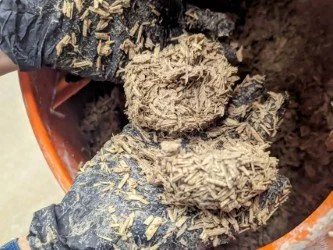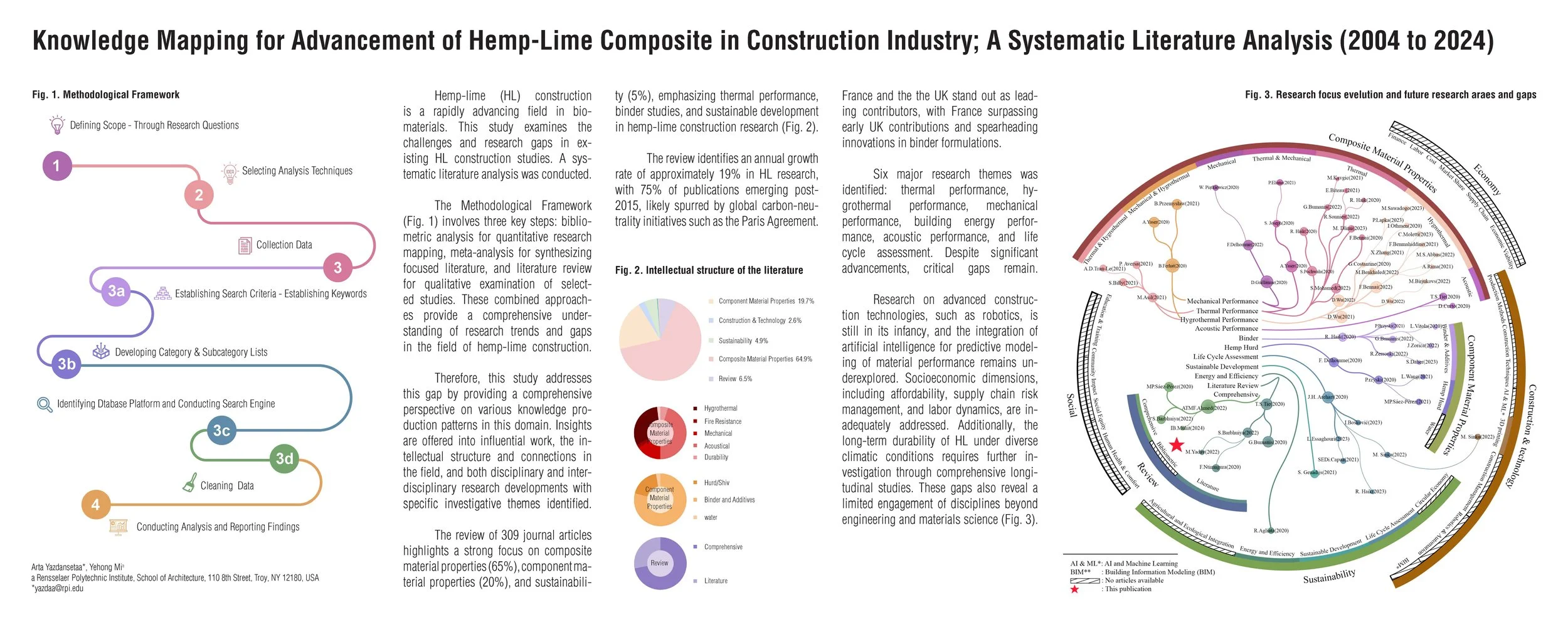CASE Faculty and Student Collaborate to Publish on Hemp-Lime Research
October 27th, 2025
CASE's Assistant Professor Dr. Arta Yazdanseta and Ph.D. Candidate Yehong (Mia) Mi have a New Publication in Journal of Material Science: Materials in Engineering. “Knowledge Mapping for Advancement of Hemp-Lime Composite in the Construction Industry: A Systematic Literature Review (2004–2024)” is an open-access study that identifies key research trends, interdisciplinary developments, and critical knowledge gaps in hemp-lime composite research. We had the opportunity to interview Arta and Mia about this body of research and it’s significant role in the future of sustainable building materials. Read on to get a behind the scenes look at the work and ethos of their paper.
Q: Can you give us an overview of this body of research?
Arta and Mia: We analyzed 20 years of scientific research on hemp-lime—a construction material made from hemp plant waste mixed with lime binder. Rather than reviewing what we already know about the material's properties, we mapped the entire research landscape: who's studying it, where the work is concentrated, which questions have been answered, and critically, which haven't. We examined 309 studies from 44 countries and used network analysis to reveal patterns invisible in traditional reviews. Think of it as creating a GPS for researchers and industry professionals navigating this field.
Q: The research spans a timeline of the past 20 years, which might be considered very recent, what is the importance of hemp-lime composite as an emerging building material? Will this paper play a role in optimising it's quickly evolving applications?
Arta: Buildings are responsible for roughly 40% of global carbon emissions, and we've spent decades focused on reducing energy use for heating and cooling. But there's another problem: the carbon released just from making building materials—concrete, steel, insulation. Hemp-lime addresses both. It insulates buildings naturally, reducing energy needs, and it actually stores carbon from the atmosphere for decades within the walls. A square meter can lock away 12-36 kg of CO₂.
Our paper identifies exactly where knowledge exists and where it doesn't. Seventy-nine percent of research has focused on material testing, but almost nothing addresses how to actually build with it at scale, what it costs, or whether people will accept it. By revealing these gaps, we're giving researchers and industry a clear direction: stop duplicating thermal performance studies and start solving the practical barriers to adoption.
Mia: Hemp–lime matters because it is both a carbon sink and a thermal–hygrothermal regulator, making it unique among sustainable materials. For my dissertation, this paper is critical because it supports its fast-moving applications by clarifying research directions, and my dissertation extends that by testing and optimizing recipes for real passive design uses.
Q: What is the most pressing gap of research and technology that you've identified in your analysis? Who should be targeting these gaps?
Arta and Mia: The most critical gap is economic viability and construction technology. We found zero publications addressing market dynamics, supply chain reliability, or cost modeling. Only 4.5% covered construction methods, and emerging techniques like 3D printing are barely explored. Meanwhile, material properties have been studied exhaustively. The real challenge lies in bridging the gap from laboratory recipes to building-scale systems and market-ready products.
Addressing this requires broad collaboration: architects need to develop assembly strategies that work with existing construction practices. Engineers must create standardized mixture specifications and building codes. Economists should model lifecycle costs that include carbon pricing. Policymakers need to establish incentives that recognize hemp-lime's carbon storage value. And crucially, the industry needs pilot projects at building scale, not just laboratory samples. The material works—we need to figure out how to build with it profitably and reliably.
Q: What is your biggest goal for this research to impact the building industry moving forward?
Arta and Mia: Our main goal is to help the building industry shift more decisively from just focusing on operational carbon to really tackling embodied carbon. The construction industry is fragmented, and there's this global push not only to reduce embodied carbon but to find methods of capturing and storing carbon in long-lasting building elements. By focusing on hemp-lime, which uses hemp hurd—a waste product from the textile industry—and readily available lime, we're turning a low-value by-product into a valuable, climate-friendly building material. In essence, we want to give industry stakeholders a clear map of how they can scale from lab recipes to practical construction systems and market-ready products and integrate this waste product into the emerging bio-industry and support a more sustainable construction future.
Q: What motivated you both to pursue this body of research?
Arta and Mia: We were motivated by a need to understand the gaps in the existing knowledge. Hemp-lime has been used in Europe for decades, especially in France, and we wanted to map out the academic work that's been done over the past 20 years. We realized there wasn't a comprehensive knowledge map that showed where the research had been and where it needed to go next. This project was really about giving researchers a starting point to see the gaps and figure out how to push the field forward. My PhD student (Mia Mi) needed to know where she could position her work for the most impact, and since this comprehensive overview didn't exist, we created it. Now, other researchers can better understand the landscape and align their efforts with where the real needs and gaps are.
Q: As a Ph.D. Candidate, how do you hope to incorporate this research and experience into your thesis and post-doctoral pursuits?
Mia: For my dissertation, this review paper gives me both orientation and direction. By mapping 20 years of hemp–lime research, it makes clear that while the material’s thermal, hygrothermal, and mechanical properties are well documented, most studies stop at basic testing. There is still a lack of systematic methods that connect recipe formulation to performance in real building contexts. My dissertation directly builds on this gap by developing a recipe–performance optimization framework. I combine material-scale experiments, numerical analysis, and data-driven approaches to tune hemp–lime for passive design strategies, particularly Internal Thermal Mass and Dynamic Insulation, where its dynamic thermal and moisture-buffering properties can make a measurable impact.
Looking ahead, I want to push this further by integrating optimization with larger-scale design systems. That means bridging material science with adaptive building envelopes, active learning, and climate-responsive modeling. My vision is not only to optimize hemp–lime recipes but also to establish a transferable methodology for other biogenic composites. In this way, the work contributes both to advancing sustainable construction technologies and to shaping a broader research agenda where materials, design, and data-driven methods interact. Ultimately, I see this research as a pathway to demonstrate that low-carbon biogenic materials are not niche alternatives but scalable, high-performance systems for the building industry.
Q: This paper is published in an Engineering Journal, as an architect can you explain the significance of this research as an intersection of the two industries? What other industries does this research intersect with?
Arta: What makes this research significant is that it reveals something fundamental: the challenge of transforming construction is too complex for any single discipline to solve alone. Engineers have built an incredible foundation—78% of hemp-lime research comes from civil and materials engineering, giving us robust data on thermal performance, strength characteristics, and material behavior. That scientific rigor is essential and irreplaceable.
But here's what our analysis shows: achieving actual climate impact requires us to work differently. We found that 79% of research focuses on laboratory material testing, while questions about cost, construction methods, occupant experience, and market adoption remain almost entirely unexplored. This isn't a criticism—it's a recognition that these questions simply fall outside traditional engineering scope. And that's exactly why collaboration is urgent.
Publishing this in an engineering journal is a deliberate call to action. We're showing that advancing hemp-lime from a promising material to an industry solution requires intentional partnerships. Engineers bring material science expertise that architects don't have. Architects understand building systems integration and can translate technical data into constructible details that engineers may not focus on. Add economists who can model lifecycle costs including carbon pricing, social scientists who study technology adoption, and construction managers who understand field implementation—suddenly you have the comprehensive team this challenge actually demands.
The paper identifies exactly where each discipline's contribution is needed. For instance, France has used hemp-lime successfully for decades, but adoption remains limited globally. Our analysis reveals why: we have excellent thermal conductivity data but almost zero research on training programs for contractors, financial risk models for developers, or building code pathways for regulators. No single researcher or discipline can address all of these simultaneously.
The significance is this: climate change won't be solved through better materials alone—it requires transforming entire systems. That transformation demands that we work across traditional boundaries, combining rigorous technical assessment with economic modeling, social research, and practical implementation strategies. This paper provides the roadmap showing where each discipline's expertise is essential, making collaboration not just beneficial, but necessary.
Q: Will you continue to hone and expand this body of research?
Arta: Absolutely. This paper is really a foundation—it shows us where the field needs to go, and there's significant work ahead. Our immediate focus is on areas where we can make the most impact based on our expertise in material performance and building systems.
What's clear from our analysis is that the field needs diversification. We identified that 79% of research concentrates on laboratory material testing, while critical gaps remain largely unexplored. For instance, social research represents only 1.9% of publications over the past twenty years. This is particularly concerning because without understanding occupant acceptance, contractor willingness to adopt new techniques, or effective training programs, even the best technical performance data won't translate to actual buildings.
The dataset we've compiled—309 studies with thousands of data points on mixture ratios, densities, and performance metrics—opens new possibilities. Computational approaches like machine learning could help identify optimal formulations across all existing research rather than conducting more isolated lab tests. Currently, that represents 0% of published work, and it's an area ripe for exploration by researchers with those capabilities.
Similarly, building-scale validation is essential. Most studies test small laboratory samples, but the industry needs long-term monitoring of actual buildings—real temperature swings, moisture levels, energy consumption over years, not weeks. The demonstration projects in France and the UK exist but haven't been systematically studied and published.
The economic and construction technology questions are equally urgent—representing virtually 0% and 4.5% of research respectively. How do we model lifecycle costs that include carbon storage value? What construction sequencing actually works? How do we integrate hemp-lime with existing building systems?
Our role moving forward is to continue asking these comprehensive questions and, where appropriate, partnering with the expertise needed to answer them—whether that's economists, social scientists, construction managers, or computer scientists. The point of mapping these gaps is to show the entire research community where their contributions are needed. Climate challenges demand that we work collectively, not in isolation.
Media Contact:
Kathie Brill, Program Manager
Brillk@rpi.edu





